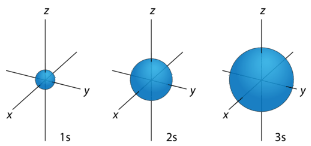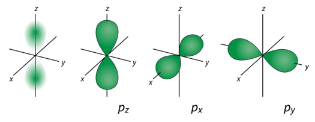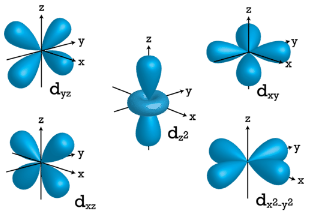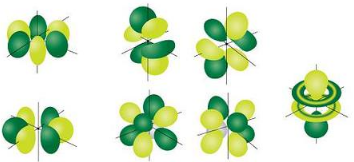
Orbitals
 المؤلف:
LibreTexts Project
المؤلف:
LibreTexts Project
 المصدر:
................
المصدر:
................
 الجزء والصفحة:
.................
الجزء والصفحة:
.................
 13-8-2020
13-8-2020
 1861
1861
Orbitals
We can apply our knowledge of quantum numbers to describe the arrangement of electrons for a given atom. We do this with something called electron configurations. They are effectively a map of the electrons for a given atom. We look at the four quantum numbers for a given electron and then assign that electron to a specific orbitals below.
s Orbitals For any value of n , a value of l=0 places that electron in an s orbital. This orbital is spherical in shape:

Figure 1: s orbitals have no orientational preference and resemble spheres.
p Orbitals For the table below, we see that we can have three possible orbitals when l=1 . These are designated as p orbitals and have dumbbell shapes. Each of the p
orbitals has a different orientation in three-dimensional space.

Figure 2 : p orbitals have an orientational preference and resemble dumbells. d Orbitals When l=2 , ml values can be −2,−1,0,+1,+2 for a total of five d orbitals. Note that all five of the orbitals have specific three-dimensional orientations.

Figure 3 :d orbitals have an orientational preference and exhibit complex structures. f Orbitals The most complex set of orbitals are the f orbitals. When l=3, ml values can be −3,−2,−1,0,+1,+2,+3 for a total of seven different orbital shapes. Again, note the specific orientations of the different f
orbitals.

Figure 4 : f orbitals have an orientational preference and exhibit quite complex structures.
Orbitals that have the same value of the principal quantum number form a shell. Orbitals within a shell are divided into subshells that have the same value of the angular quantum number. Some of the allowed combinations of quantum numbers are compared in Table 1:
Table 1: Electron Arrangement Within Energy Levels

 الاكثر قراءة في كيمياء عامة
الاكثر قراءة في كيمياء عامة
 اخر الاخبار
اخر الاخبار
اخبار العتبة العباسية المقدسة


